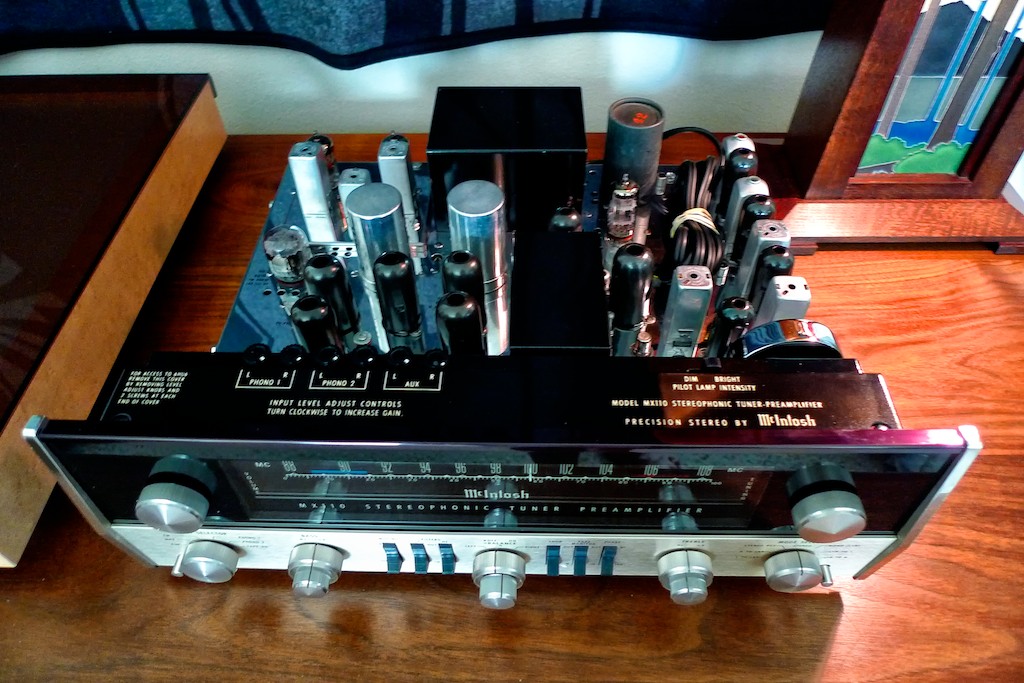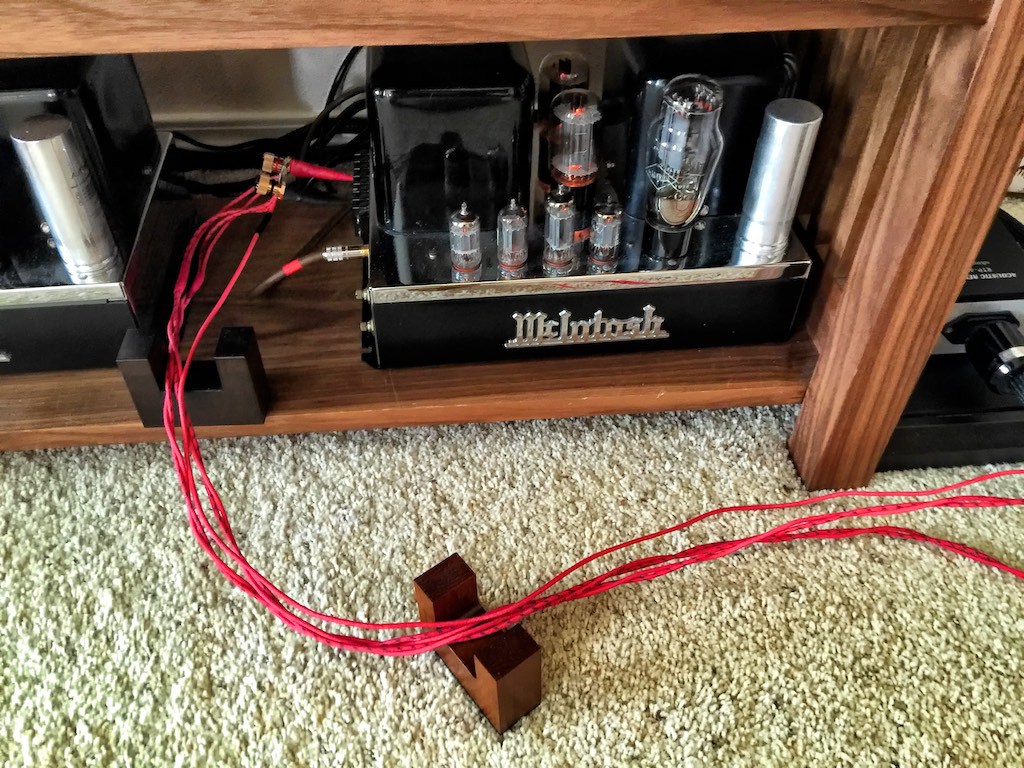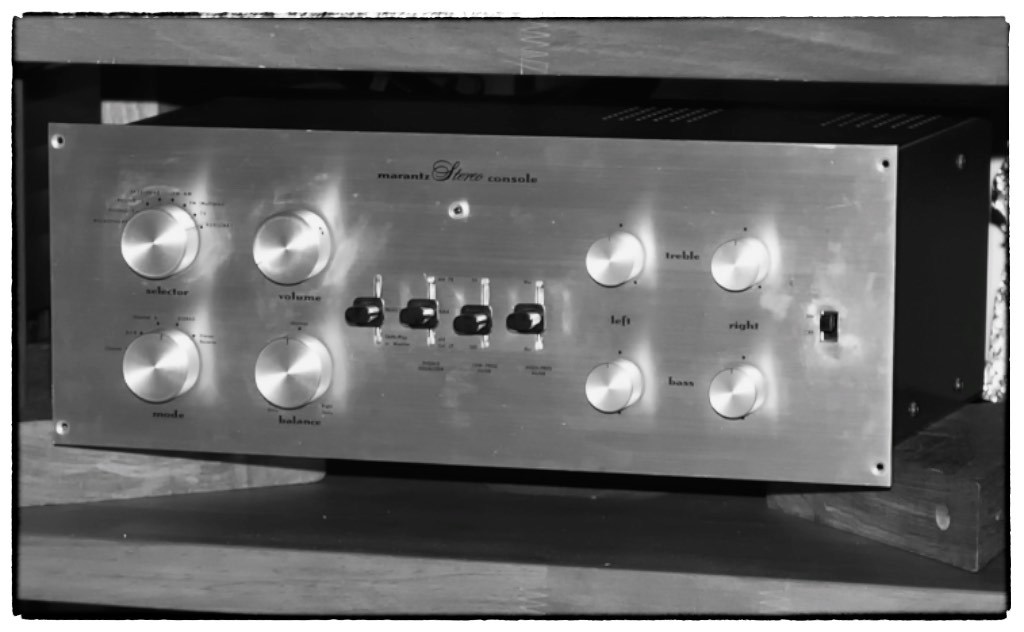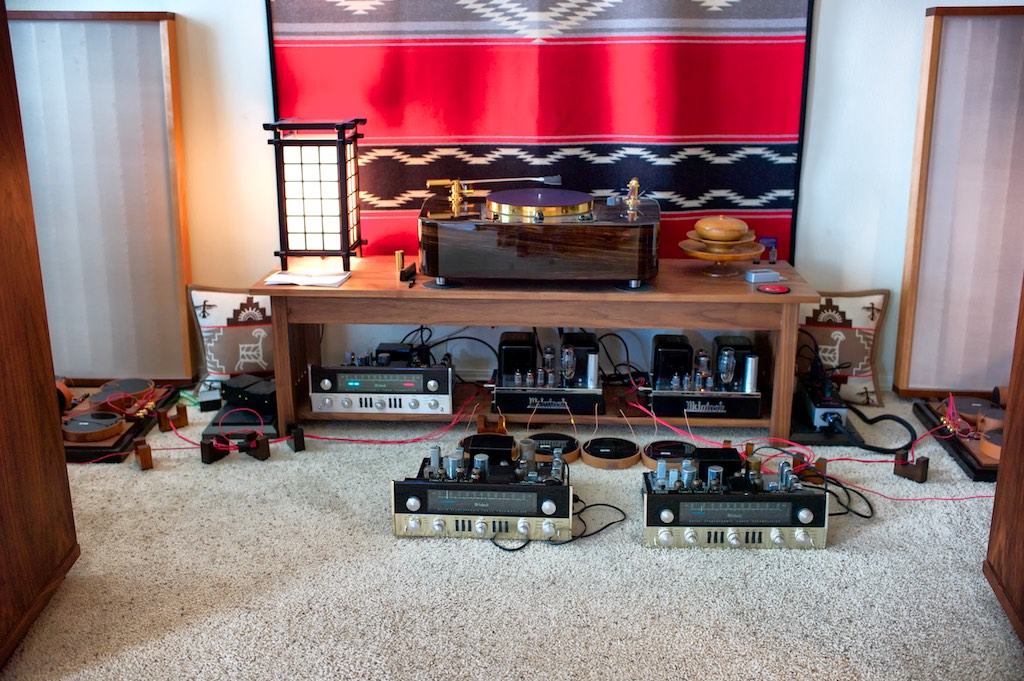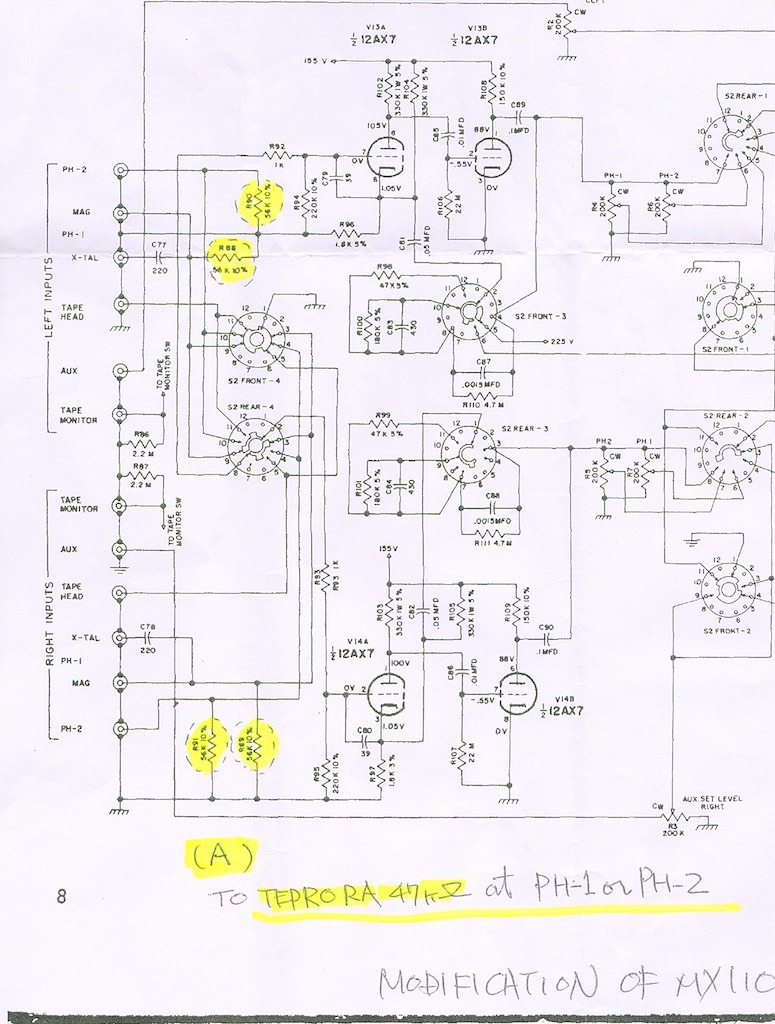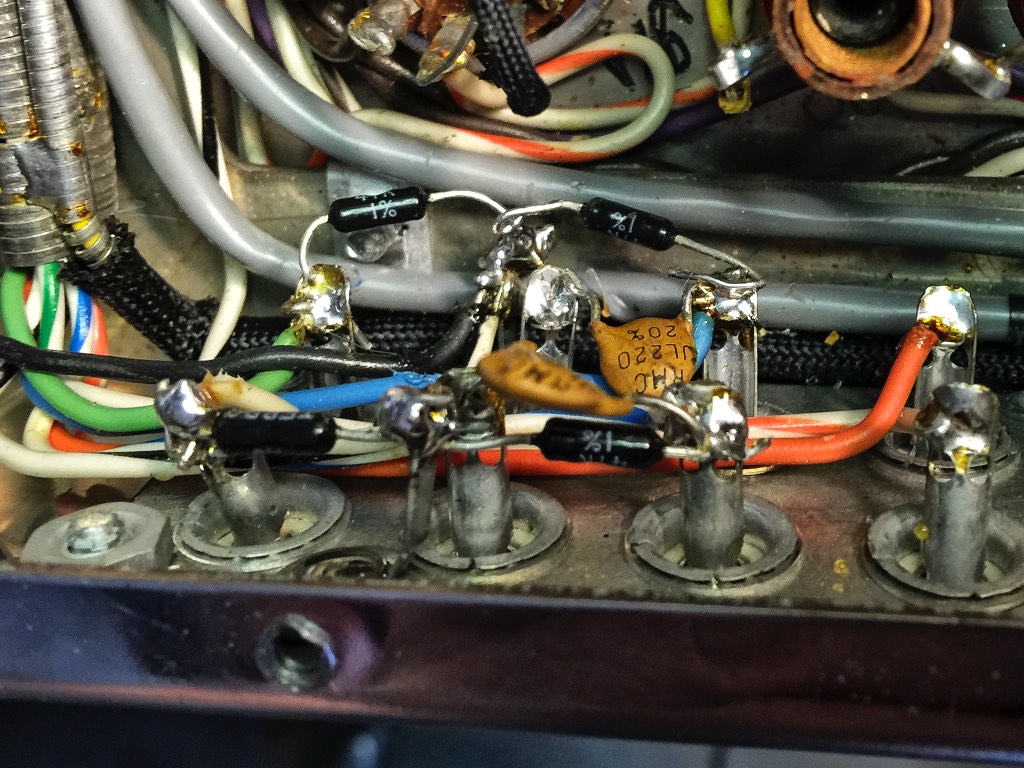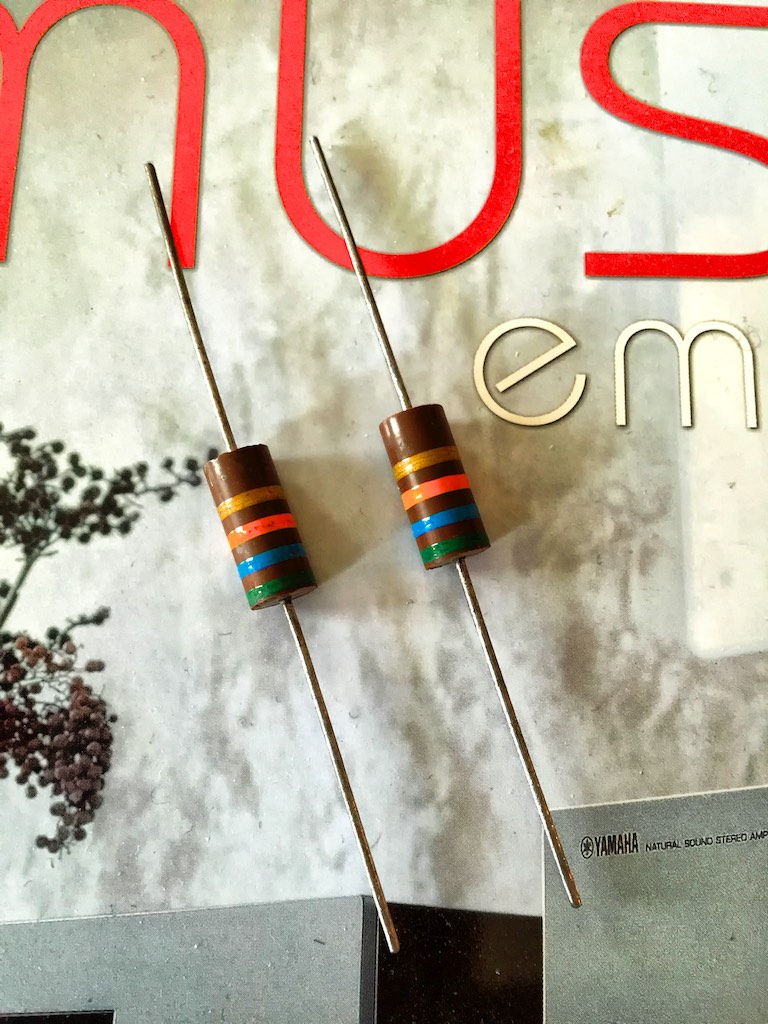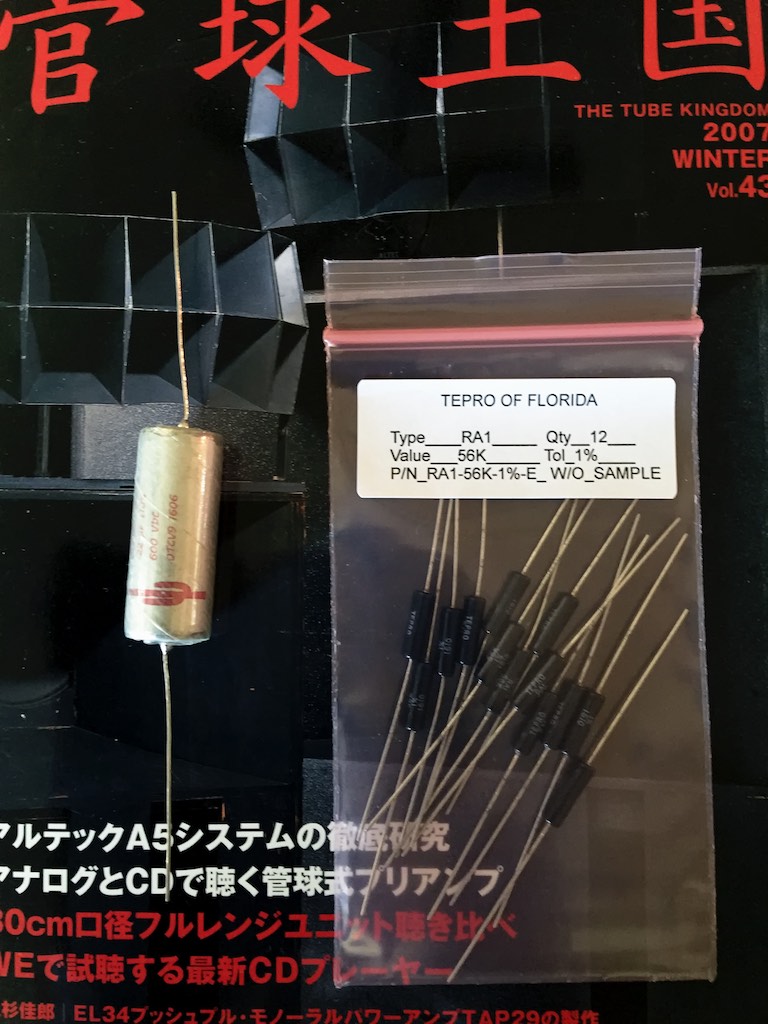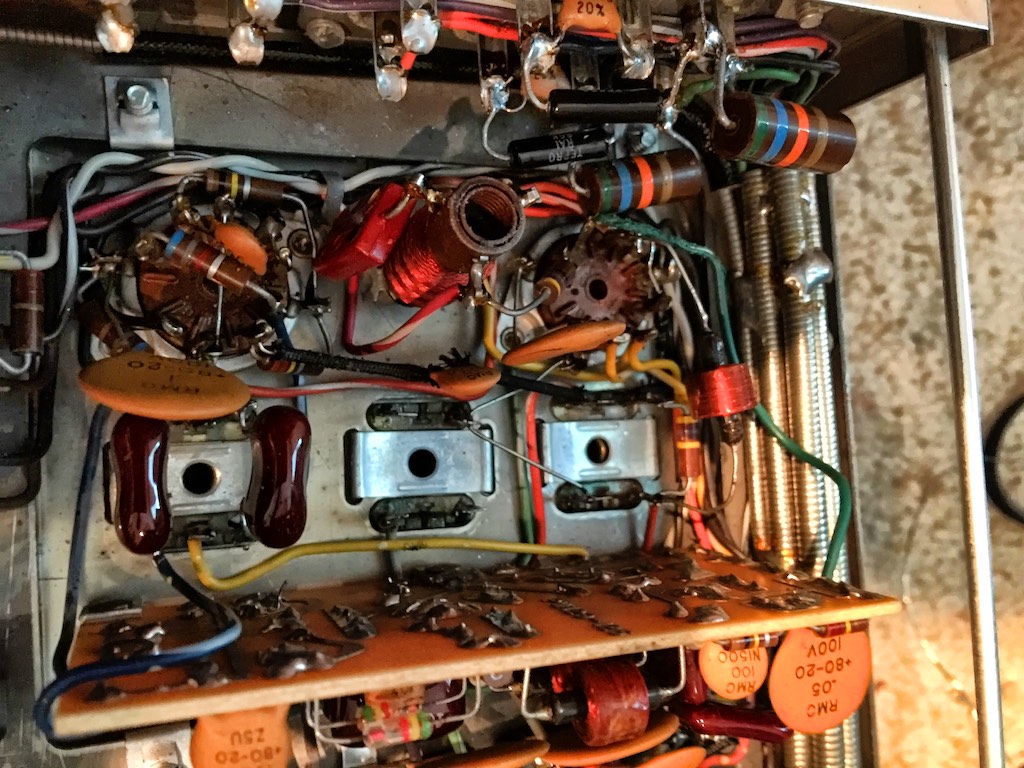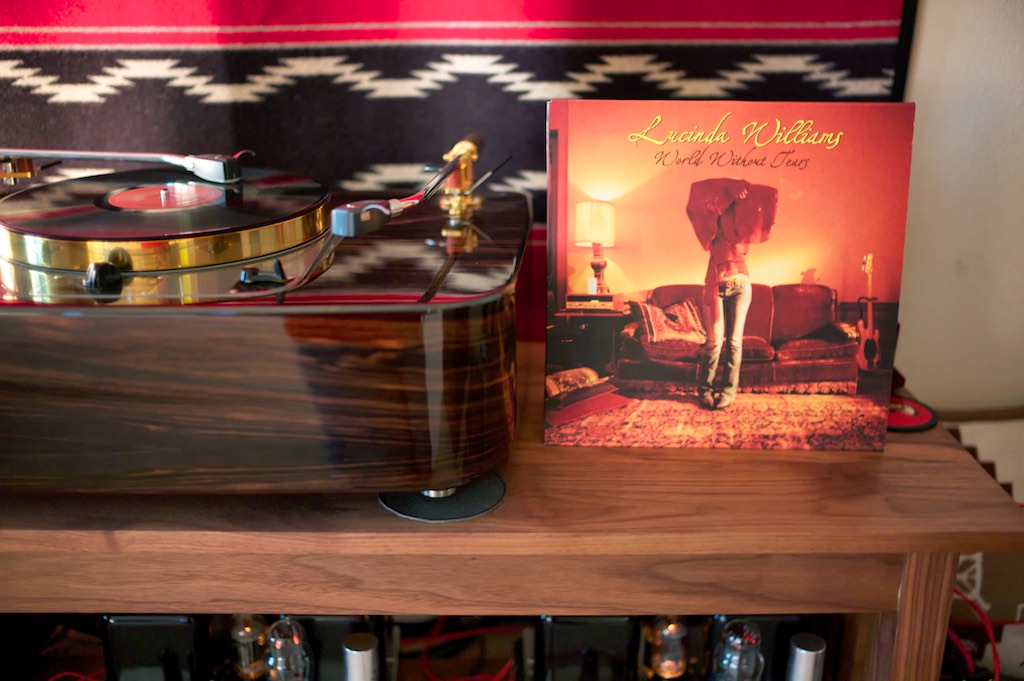Have you ever woken up in the middle of the night with a major revelation? In my case my major revelation came at 2:53 a.m. last night, according to the screen on my iPhone.
It was three thoughts coming together that triggered my overall revelation, but I want to tell you the story in the sequence that it occurred to me, rather than tell you all at once here in the beginning of this post.
In case you are new to The Vintage McIntosh MX110 Tuner-Preamplifier Adventure let me give you a quick recap of what got us here.
Some years ago my good friend Ron, who really loves vintage hi-fi gear, got me interested in the vintage hi-fi scene by bringing over some really nice vintage hi-fi kit for me to hear here at Jeff's Place.
Slowly the realization dawned on me that vintage hi-fi gear was way more musical than most modern 'high-end' hi-fi gear. I thought vintage gear was fun to own too because of its classic status in our audio history, which I have grown to appreciate more and more as time goes on, and often vintage gear can be a bargain price-wise compared to contemporary high-priced 'high-end' gear.
I ended up buying some restored vintage vacuum-tube McIntosh hi-fi gear as my entry into the world of vintage hi-fi: the MX110Z tuner-preamplifier, the MC30 monaural amplifiers, the MC225 stereo amplifier, and the MC240 stereo amplifier.
I found the world of vintage hi-fi gear to be so satisfying that I wrote up my experiences with the Mac gear as a feature article for Positive Feedback back in Issue 77, The Vintage McIntosh Experience: A Musical Ride With The MX110Z Tuner/Preamplifier and the MC30, MC225, and MC240 Amplifiers.
Then I met Yazaki-san during the review of the SPEC RSA-M3 EX Real Sound Amplifier, which appeared in Positive Feedback Issue 78, and found out that Yazaki-san was also a vintage hi-fi enthusiast.
During our discussions Yazaki-san introduced his concept of Real Sound to me, which he described to me as reproducing a "tone that is beautiful, rich, and penetrating, as if appealing directly to the human emotions, a real three dimensional field, and a musical sound full of dynamism! Accordingly, we could find more clearly the unique fine technique of player and be moved by feeling the soul of virtuoso directly."
I also found out during our discussions that Yazaki-san loves to modify vintage hi-fi gear (as well as design new SPEC hi-fi electronics) in his personal pursuit of Real Sound, and he proposed to me that we embark upon a Real Sound adventure here at Jeff's Place. Of course I said, "Yes!"
For our Real Sound adventure Yazaki-san suggested we start by making three changes to my system: (1) the addition of vintage NOS Western Electric WE16GA wire as speaker cables, (2) the addition of the neo-vintage Belden 8402 microphone cable as RCA interconnects, and (3) to make some modifications to my vintage McIntosh MC30 monaural amplifiers.
I installed the Western Electric WE16GA wire into my system as speaker cables, and was so impressed with the result that I eventually re-wired my Westminsters internally with it, as well as my external Duelund CAST crossovers. I also installed the Belden 8402 microphone cable RCA interconnects into my system, and the synergy between the Western Electric and Belden 8402 produced an incredibly musical result.
My good friend Ron volunteered to do the Real Sound modifications to the MC30 monaural amplifiers, and so Yazaki-san, Ron-san, and I embarked upon our Real Sound adventure!
You can read about the details of our successes with our Real Sound adventure in my article for Positive Feedback, Adventures in Real Sound with Mr. Shirokazu Yazaki, back in Issue 81.
I'm simplifying quite a bit from the article in saying this, but the essence of our Real Sound approach for the MC30 monaural amplifiers was to utilize a combination of vintage & modern components and concepts to strengthen the power supplies, and to replace key resistors & capacitors in the signal path with premium vintage & contemporary choices, all with the end goal of improved musical & sonic performance in the pursuit of Real Sound.
Needless to say, our Real Sound adventure with the MC30s was a resounding success, and Ron & I were very impressed with Yazaki-san's abilities in making recommendations for Real Sound modifications from a distance.
For the next chapter in our Real Sound adventures Yazaki-san proposed that we make a series of similar Real Sound modifications to my vintage McIntosh MX110Z tuner-preamplifier like he had made to his vintage Marantz 7 preamplifier, which for now I'll briefly refer to as Real Sound Modifications A (phono input resistors), B (first stage cathode follower of the high level input), and C (power supply upgrades), without going into the details (more details to come).
So that's what led up to the topic of this post, the McIntosh MX110Z Tuner-Preamplifier Real Sound Adventure.
Buoyed by our success with the McIntosh MC30 monaural amplifiers Real Sound adventure, we decided to even be more courageous in our Real Sound MX110 adventure, with Ron modifying Leo's, George's, and my MX110s according to Yazaki-san's suggestions, with variations of Modifications A, B, and C, so we could showcase the different attributes of the sonic & musical palette of the Red, Green, and Blue Cactus Arizona Capacitors, and the other components we were using for the modifications.
I thought that by varying & blending the Tepro RA resistors, Arizona Capacitors, etc., like an artist varies & mixes colors, we would come up with three MX110s that - just like with the MC30 monaural amplifiers - would wow us, with a range of tonal attributes, instrumental color, and sonic attributes, that would be uniquely captivating and provide us with three different insights into the musical experience, and provide us insights into the equipment 'voicing' process.
Well, what we ended up with for our courageous efforts were three MX110s that sounded worse than a stock vintage MX110 from the McIntosh factory, which was a bit of a bitter pill to swallow after all our efforts. What happened? It couldn't be!
It is only fair to say that a stock MX110 already sounds amazingly good (read more about it here in Positive Feedback), and our efforts have given us an increased level of respect for the original work McIntosh did in voicing the MX110, and for their choice of components - those guys were amazing!
Yes, we were a bit caught out by the results. While deciding on how best to proceed, we had a few false starts & dead ends, and then we decided we should go back and look at each change we made in the MX110s' circuitry, and either figure out what to do for improved musical & sonic performance at each step, or as a last resort, we would go back to the stock configuration.
Our discomfiture aside, a wonderful thing has happened in that our vintage McIntosh MX110 Adventure has turned into an unparalleled learning experience about component voicing, but not in the way I had first anticipated!
I have had a blast learning about how the components in a circuit work and contribute to the sonic & musical prowess of the MX110, how to read the circuit diagram, how to do some simple parts swaps, and so forth.
Our MX110 adventure has been a terrific learning experience, and I am slowly gaining a tiny bit of competence with a soldering iron in modifying circuits, and thank goodness for Yazaki-san & Ron-san for all their insight, help, encouragement, and guidance, and to Ron-san for his patience in letting me peer over his shoulder while doing mods, and explaining them to me!
That's really helped me learn about what's going on in a circuit and given me the confidence to do a few simple modifications myself.
I'm even starting to get some ideas of my own for modifications (very dangerous!), which I'm going to talk with Yazaki-san & Ron-san about at some point in the future to see if they have any merit.
Ok, time to move on and tell you how the MX110 Adventure is evolving!
Modification A, the R88 & R90 and R89 & R91 phono input resistors:
First up were the phono input resistors at R88 & R90 (left inputs) and R89 & R91 (right inputs), for PH-1 & PH-2, which have a major influence on the sound quality of the phono stage of the MX110.
In Modification A we replaced the stock 56KΩ Allen Bradley carbon composition phono stage input resistors with a series of metal film resistors, but none of the metal film resistors we tried were able to match the stock Allen Bradley carbon comp's for their well-balanced combination of musicality & sonics.
Our first attempt at improving the phono input resistors was to use 47KΩ Tepro RA metal film resistors at R88 & R90 and R89 & R91 instead of the stock 56KΩ Allen Bradley carbon comp input resistors, which turned out to be a sonic & musical disaster.
We learned a valuable lesson: the MX110 does not like its input resistors varied from 56KΩ. So we put a pair of NOS Allen Bradley 56KΩ 2-watt resistors (stock were 1/2-watt) in for PH-2 to use as a control for comparative purposes, and on PH-1 we tried the NOS 56K Ohm 1/2 watt Shinkoh tantalum resistors (as used on the original Kondo Ongaku amplifier), and the 56K Ohm Vishay VAR-Series ”naked ladies” metal foil ‘z-foil’ resistors, so we could hear what would happen.
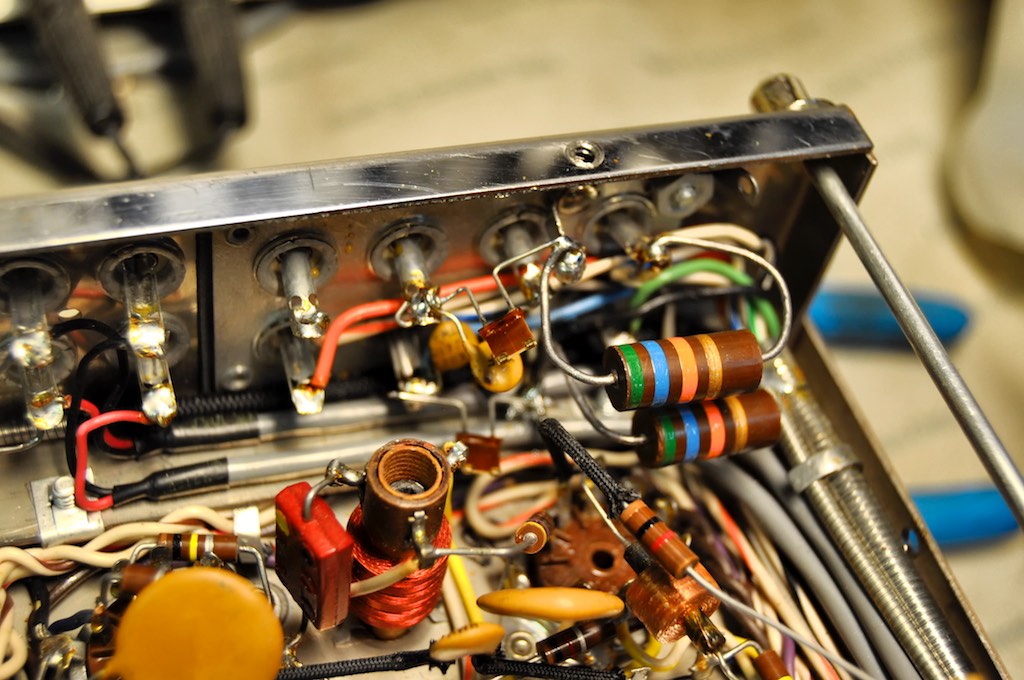
56KΩ Vishay VAR-Series 'Naked Lady' resistors to the left of the Allen Bradley's in the upper right-hand corner of the photo.
We also wanted to try the 56KΩ Tepro RA, but at that time we were doing those mods there were none to be had. Gary at Tepro wanted to make some up for us to try, but it wasn't trivial to do, and it was going to take a while for Tepro to gear up to make the 56KΩ Tepro RA resistors.
Both the Shinkoh tantalum resistors and the Vishay VAR-Series resistors had some commendable aspects to them, notably they were very transparent, very resolving, and in the case of the Vishay VAR-Series, very smooth sounding throughout the frequency range, compared to the NOS Allen Bradley carbon comp resistors.
However, the Allen Bradley carbon comp resistors had better 'tone'; they were richer, warmer, more colorful, had a more natural timbral presentation of texture, and importantly, they were more emotionally involving than the metal film resistors we tried.
The NOS Allen Bradley carbon comp resistors gave up sonic ground to the metal films in transparency, resolution, and a certain amount of smoothness (the Vishay's), but when it came to the overall musical experience, and the level of emotional engagement, the Allen Bradley's were The King.
We had also removed the stock 47KΩ Allen Bradley cathode resistors at R116/R117 and replaced them with the Tepro RA 47KΩ resistors as part of Modification C, as the cathode resistors have a big influence on the sound & musicality as the signal current flows through them. We had also changed out the stock 220kΩ Allen Bradley carbon comp resistors at R94 & R95 for 1MΩ Roederstein metal film resistors in an attempt to balance out the 47KΩ Tepro RA resistors on the phono inputs.
In order to sort things out we went back to the stock Allen Bradley's at R116 & R117 and R94 & R95. I stripped out all the metal film resistors we had put in the MX110s and replaced them with NOS Allen Bradley's with stock resistance values, albeit NOS 2-watt versions of them, which I think sounded better.
Putting back in the Allen Bradley's restored most of the musicality of the MX110s, except in the region of 'hotly' recorded female vocals and muted trumpets in less than ideal recordings, which still sounded a little bit unnaturally harsh to me, but all-in-all, things were starting to sound very promising.
Even though the metal film resistors we tried represented among the best of their kind, I had all but given up on metal film resistors.
Then a care package of 56KΩ Tepro RA 1/2-watt resistors arrived from Gary at Tepro.
Given our previous results with metal film resistors, I probably wouldn't have even tried more metal film resistors, but I know how highly regarded Tepro RA resistors are by Yazaki-san, and Gary went to a lot of effort to get some 56KΩ Tepro RA resistors made up special for us to try, which was a really nice thing for him to do.
So I soldered in a pair of the 56KΩ Tepro RA 1/2-watt resistors for PH-1 on Leo's MX110 to replace the Shinkoh tantalum resistors that I had tried there earlier, and I left the pair of NOS 56KΩ Allen Bradley 2-watt carbon comp resistors on PH-2 to use as a baseline reference for comparison.
I gave the MX110 a quick listen to make sure I hadn't screwed anything up, and everything was operating normally with the 56KΩ Tepro RA 1/2-watt resistors on PH-1, so I was good to go for some preliminary listening impressions.
It took me by surprise to hear that there was a huge positive difference in sound & musicality between the 56KΩ & 47KΩ Tepro RA 1/2-watt resistors on PH-1.
It was not what I was expecting.
As I thought more about this result with the 56KΩ Tepro RA 1/2-watt resistors on PH-1, I remembered that not only had I changed from the 47KΩ Tepro RA's back to 56KΩ Tepro RA 1/2-watt resistors on PH-1, but I had also gone back to NOS Allen Bradley 2-watt resistors at R116 & R117 and R94 & R95.
So it wasn't just the addition of the 56KΩ Tepro RA 1/2-watt resistors on PH-1 that made such a big difference, but it was also the result of combining them with the Allen Bradley 2-watt carbon comp resistors at R116 & R117 and R94 & R95.
As I was thinking about the effects of blending these two types of resistors, I remembered what Yazaki-san had told me during the MC30 monaural amplifiers adventure, which I wrote about in the Adventures in Real Sound with Mr. Shirokazu Yazaki article in Positive Feedback Issue 81.
"I found the almost ideal sounding resistor, the Tepro RA type, which has fine tonal quality and is also very clear sound though entire range. I have experienced the musical sound of Allen Bradley solid carbon resistor, and it might be the symbol of American sound from the good old days, but even in my Marantz Model 7 I used metal film resistors in pivotal points. The Tepro RA type resistor would provide the needed accuracy, but accordingly, the blending of the different type of resistors will bring out outstanding sound quality."
That's the secret - getting the resistor blend right across the signal path.
I think I've hit upon a really good blend of Tepro RA resistors & NOS Allen Bradley resistors for the MX110, by using the Tepro RA 56KΩ 1/2-watt resistors as the phono input resistors at R88 & R90 (left inputs) and/or R89 & R91 (right inputs) for PH-1 & PH-2, the NOS 220kΩ 2-watt Allen Bradley carbon comp resistors in the key positions of R94 & R95, and NOS 47KΩ 2-watt Allen Bradley resistors at R116/R117, I'm hearing a really nice combination of sonics & musicality that I think quite a lot of you would like.
So anyways, the lesson I learned here was that it is finding the right combination of Tepro RA & Allen Bradley resistors to use at various points in the circuit is the key to getting the best sonic & musical performance from the MX110.
I was impressed enough with what I was hearing from the 56KΩ Tepro RA's that I wanted to have Ron & Leo hear them, so I asked if they could come over on the weekend and do a bit of comparative listening with me. The plan was that we would compare the NOS Allen Bradley 56KΩ 2-watt carbon comp resistors on PH-2 to the Tepro RA 56KΩ 1/2-watt resistors I had installed on PH-1 (as well as something else that I will tell you more about in the next post).
We listened to a variety of music from LPs that were done extremely well, and to some LPs that were not done so well (but great music), so we could get an idea of performance across a variety of contexts.
Leo's MX110, with the Green Cactus Arizona Capacitors at C93 & C95 and C94 & C96 in the first stage cathode follower of the high level input, sounded extremely good playing vinyl records of exceptional quality from PH-2 with the Allen Bradley carbon comp resistors, and still made for a music listening experience that was compelling & enjoyable when playing records of lesser quality. Non-optimally recorded female vocals or muted trumpets still had a trace of edginess, but the performance was certainly in the acceptable range to allow for musical enjoyment, and sounded bloody good otherwise!
So in a nutshell, with the NOS 56KΩ 2-watt Allen Bradley resistors on PH-2, Leo's MX110 was very impressive playing back the best records, and could even play rather poor records in a way that flattered the music and allowed for an intense dose of musical enjoyment. That's a pretty big deal! Musically and sonically things were really singing with this combination of components, and our hard work was paying off.
After we played records for awhile through the MX110 with the Allen Bradley's on PH-2, we switched over to PH-1 with the Tepro RA 56KΩ 1/2-watt resistors, and we listened to the same variety of music again.
Here's what I heard: I thought the Tepro RA 56KΩ 1/2-watt resistors on PH-1 mostly combined the best musical traits of the NOS 56KΩ 2-watt Allen Bradley's with the best sonic traits of the Shinkoh or Vishay metal film resistors, with one exception, which I'll describe for you in a moment.
The Tepro RA metal film resistors actually beat (!) the NOS Allen Bradley carbon comp resistors at their own game by having even better 'tone' by being richer, warmer, more intensely colorful, and having an even more convincing timbral presentation of texture & tone color. They were also at least a match for the NOS Allen Bradley's for emotional involvement, which is high praise indeed, as the Allen Bradley's excel in that regard.
So the Tepro RA's not only scored a big hit by being as musically compelling as the NOS Allen Bradley's, but sonically they were superior: more transparent, more resolving, threw a much larger sound space, had better bass definition, had quieter & blacker backgrounds, and had a very smooth & liquid style of presentation that I found really appealing.
After hearing the Tepro RA 56KΩ 1/2-watt resistors on PH-1 I understand much better why Yazaki-san likes the Tepro RA's so well.
Are the Tepro RA resistors better all-around both musically & sonically than the NOS Allen Bradley's? They very well might be, but I'm not completely sure yet. I can say that they are very nice when blended with the Allen Bradley's in the correct proportion.
On the really well recorded albums we listened to, the Tepro RA's were extremely impressive by any criteria you could care to name, and they fairly easily bested the NOS Allen Bradley's, both musically and sonically, which came as a complete surprise.
There is one aspect of the Tepro RA's performance that I want to talk about more, and where I thought that the Allen Bradley's still bettered the Tepro RA's, and that was on the poorer recordings we listened to where the female vocals (or muted trumpets) were too edgy & forward, too 'hot'.
Ron mentioned he thought the carbon comp Allen Bradley's might provide a smoothing / smudging effect to the forwardness / edginess that made those poorer recordings more enjoyable to listen to than with the more transparent & resolving Tepro RA's.
I am not sure if the more transparent & resolving Tepro RA's are allowing those particular sonic issues to become audible that the less transparent & lower resolution Allen Bradley's screen out, or if those sonic issues are contributed to in part by the Tepro RA's sonic signature, or perhaps there's some other aspect of the MX110's performance that we haven't quite got nailed down yet that will make the issue go away.
My guess is that the Tepro RA's are allowing us to hear an issue that we still need to sort out in our MX110 modifications, but in any event, I want to do a lot more listening across a broad spectrum of music that is both recorded well, and not so well, before coming to any final conclusions about the Tepro RA resistors.
I am impressed enough with the Tepro RA 56KΩ 1/2-watt resistors on PH-1 that I think I'm going to install a set on each of the three MX110s (Leo's, George's, and mine) so we can collect some longer term impressions about how they compare to that vintage musical Gold Standard that are the Allen Bradley carbon comp resistors.
If you get a chance give the Tepro RA resistors a try, I think you'll like them, and be sure to let me know what you think about them in your application.
As I mentioned earlier, the Tepro RA line of resistors are now available through Parts Connexion. I just went out and checked PC's web page, and I didn't see the Tepro RA 56KΩ 1/2-watt resistors listed yet, but I just received mine from the first batch, so they should be available shortly from PC.
The Book of Revelation
I started out this blog post by telling you how I woke in the middle of the night with a revelation about the MX110 adventure.
It was three thoughts coming together that triggered my overall revelation, the first being Yazaki-san's comments about blending Allen Bradley & Tepro RA resistors from Adventures in Real Sound with Mr. Shirokazu Yazaki, the second was Steve Hoffman's description of the MX110's sound that I described in The Vintage McIntosh Experience, and the third was from my blog post Kindred Spirits: Kato-san Checking in from Hakodate, Japan!.
Yazaki-san said, "I found the almost ideal sounding resistor, the Tepro RA type, which has fine tonal quality and is also very clear sound though entire range. I have experienced the musical sound of Allen Bradley solid carbon resistor, and it might be the symbol of American sound from the good old days, but even in my Marantz Model 7 I used metal film resistors in pivotal points. The Tepro RA type resistor would provide the needed accuracy, but accordingly, the blending of the different type of resistors will bring out outstanding sound quality."
I think that the take away point from what Yazaki-san said is that it is discovering the optimum blending of Allen Bradley and Tepro RA resistors that "will bring out outstanding sound quality".
Now think about Yazaki-san's friend Kato-san had to say about the classic preamplifier circuits used in the Marantz 7, McIntosh C-22, McIntosh MX110, and Audio Research SP-6, in my blog post about Kato-san. Each one of these preamplifiers are different, and as a result, each one of them necessarily have different sonics and musical traits that have to be addressed individually, which means there is no 'one size fits all' set of components that will be optimum for them.
For example, I listened to my friend Leo's vintage McIntosh C-22 preamplifier, and it sounds a different than the McIntosh MX110, but very good.
The McIntosh MX110 and C-22 sound different than the Audio Research SP-6, which also sounds very good.
The Audio Research SP-6 sounds different than the Harmon Kardon Citation I preamp, which also sounds very good!
So if you want to take any of these already really good vintage gems to the next level, the level of Real Sound, well you'll have to discover the optimum blend of resistors (and other components) to use in each of them to bring out the exceptional sonic & musical quality that each is capable of.
Take for example the Citation 1, which has the most laid back and elegant presentation of high frequencies of all these vintage preamplifiers that I have heard. I suspect that with its warmth and sophisticated high-frequency balance it would be served well by an extra dose of Tepro RA resistors in the Tepro RA & Allen Bradley resistor blend. It will take experimentation & inspiration to figure out what that optimum blend is.
Now think about what Steve Hoffman said about the vintage McIntosh MX110, "First I played the Nat King Cole "Just One Of Those Things" album, the second song "A Cottage for Sale" in stereo. Has nice dynamics, tonality, life like sound, etc. Holy cow, it sounded wonderful on the MX-110. I mean spooky real. I was astounded at how good it sounded. The McIntosh was really holding it's own in the system ... the McIntosh reproduced the sound with authority and a really spooky 3-D sound that is not like real life, but larger than life. Interestingly, the tonality, the crucial thing, stayed pretty much the same in the system, which was really interesting to me. Usually these old tube pieces are quite colored. Not this gem. I played the Beach Boys and Ella Fitzgerald "Clap Hands" and some Ray Charles Atlantic stuff, the Beatles, the Art Pepper, a Deep Purple cut, the usual mismosh. Everything sounded so interesting with this MX-110. Not totally accurate but a sort of enhanced reality brought on by this liquid, expressive mid-band that just took my breath away."
Steve's description of the MX110 fits it to a "T". When I thought about what Steve said about the MX110 being uncolored, it dawned on me that particularly for Modification A where we changed the input resistors, that any resistors we put in that were leaner than Allen Bradley's would not serve the MX110's overall tonal balance well, it would start to get lean and harsh, and that's exactly what happened with the combination of components we were experimenting with.
If you want to use metal film resisters on the MX110's phono inputs they are going to have to have tone that is warmer, lusher, and more colorful than the Allen Bradley's they replace in order to be an improvement, otherwise you are better off staying with the Allen Bradley's.
So it seems that the Tepro RA 56KΩ 1/2-watt resistors on the MX110's PH-1 tone bested the NOS 56KΩ 2-watt Allen Bradley's in tone, with the sonic traits of greater transparency and resolution that you get from metal film resistors.
Ultimately, finding the right blend of components that best suits a particular preamplifier is done through a process of experimentation & inspiration, and it is quite an adventure, and one that I encourage you to give a try, as it is a blast!
Give the Tepro RA resistors a try, I think you'll like them, and be sure to let me know what you think about them in your application. Yazaki-san has been sharing reports from the field with me about the successes people have been having with the Tepro RA's in various modifications of vintage gear, so it's getting interesting.
I have much more to tell you, things are really starting to click in our MX110 adventure!
Thanks for stopping by!




